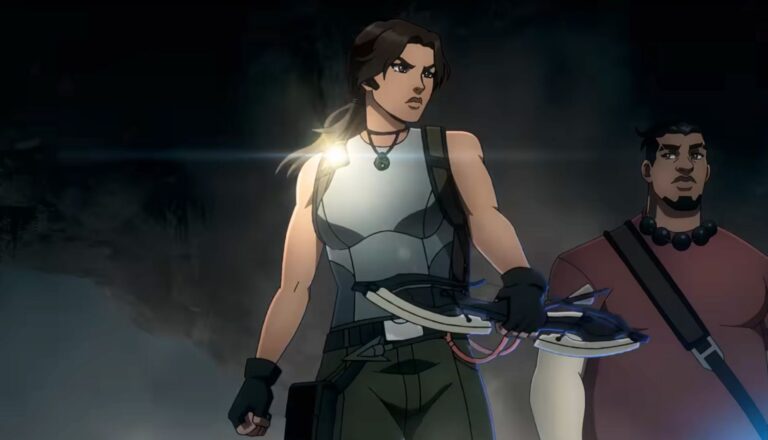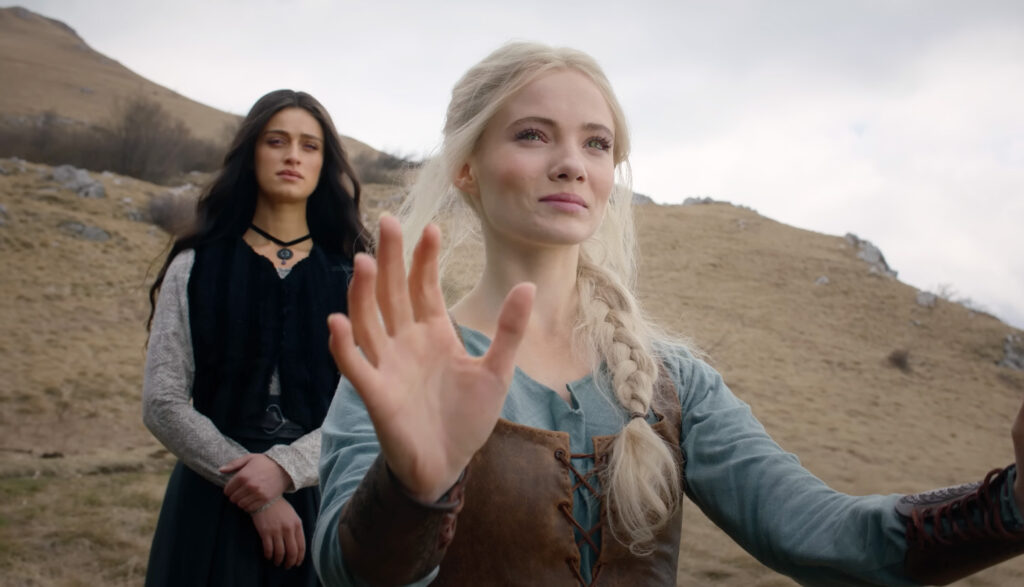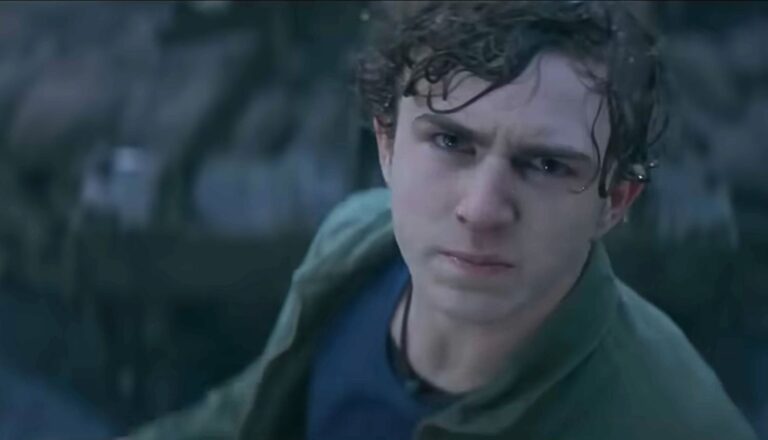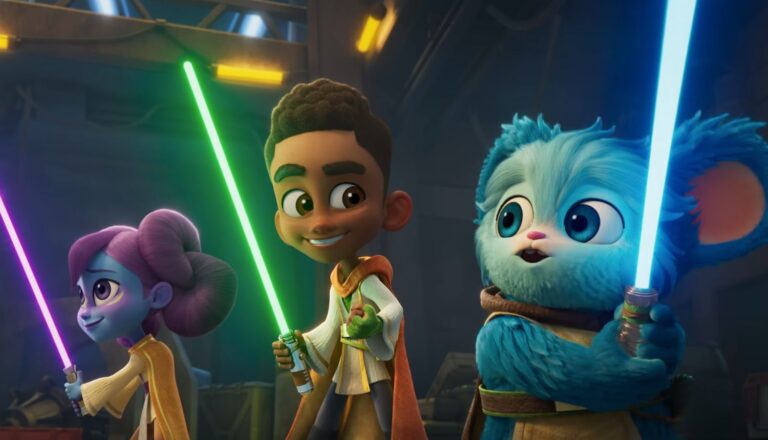
Tomb Raider: The Legend of Lara Croft
Lara Croft may raid tombs, but viewers of this show will need to be careful they don’t let its content raid their homes.

In a world filled with monsters, sometimes the scariest are … us.
It’s not just fans of The Walking Dead and anyone who’s spent a lot of time in the DMV who has learned this. Geralt, the intrepid monster hunter from Rivia, understands this truth as well as anyone. Oh, sure, he can kill gigantic spiders and werewolves and golems, and do it well. That’s what witchers are literally made to do, after all. They’re a bit Frankensteinian themselves, modified by magic to be stronger and faster and more magical than most mere mortals—tailor-made to deal with any dragons or demons that come nigh.
But fighting monsters has taken its toll on the ranks of the witchers, and those who are left aren’t the most popular folks in town, as a rule. People can be jerks sometimes, even to those who’ve just saved the city from a lurking striga.
But Geralt finds that he’s got to deal with more than just cranky smallfolk. Seems this unassuming monster hunter has gotten involved with political intrigue and a cataclysmic war that could wreck the whole continent. And in Season Three, he’s been saddled with something—or rather someone—else: a princess named Ciri, who’s linked to Geralt by destiny.
The first season involved a great deal of jumping around various timelines in order to introduce us to the story’s three main characters: Geralt, Ciri and the intimidating sorceress Yennifer—Geralt’s sometime rival, frequent paramour and, it would seem, his true love. Now the timelines have coalesced and are running at pace alongside each other, even if the characters themselves are sometimes leagues away. All of them are caught in the politics of day, featuring warring kingdoms, confused loyalties, duplicitous motives and sometimes horrific battles.
Also, monsters. Oh, so many monsters. In fact, while the show boasts political mechanizations aplenty, the manticore’s share is devoted to Geralt doing what he does best: investigating and killing foul beasties, which makes The Witcher feel part Game of Thrones, part a weird sort of X-Files. He’s like the fantasy world’s best pest exterminator, where the roaches might be 20 feet long.
Netflix’s TV-MA-rated series The Witcher has its roots in a series of fantasy novels written by the Polish author Andrzej Sapkowski, though most would-be viewers may be drawn to the show because of the popular videogame series (also based on Sapkowski’s work).
And the show embodies, from what I gather, the spirit of the game: Geralt is fearsome, sly, sarcastic, somewhat principled and ever-so-ready to smooch passing maidens and strip down to his birthday suit with little provocation.
Indeed, lots of folks on this Netflix show are happy to strip down and dive into bed with a lad or lass should the opportunity present itself. And Netflix seems to be happy to show us everything it possibly and legally can.
And then, of course, there’s the blood. And the severed body parts. And the heaping piles of entrails. The M-rated Witcher games are, according to our reviewer Bob Hoose, some of the bloodiest around, and the show hasn’t throttled back any on that content. If anything, it’s worse—because the flesh and blood thrown about here is, y’know, real flesh and blood. (Well, simulated real flesh and blood, but you get the drift.)
Viewers must navigate the show’s magical underpinnings as well—some of which lean quite dark. And if even discerning viewers simply shut their eyes during the entirety of each hour-long episode to guard themselves … well, they’ve still got to hear all the profanities.
The Witcher will lose its star Henry Cavill after the current season is done, with The Hunger Games’ Liam Hemsworth stepping into Geralt’s oversized boots in Season Four. But we can count on one thing to stay the same in Netflix’s popular fantasy: the problems.
Geralt, Ciri and Yennifer begin the episode hopping from home to home to keep Ciri safe from those who’d do her harm. Meanwhile, Yennifer tries to teach Ciri how to use her considerable magical potential. But opposing forces are at work, including a band of elves and a disturbing fire sorcerer. They mean to capture Ciri by any means possible.
If Geralt and Yennifer seem a bit chilly toward one another at the outset, it’s because of an event in the second season—wherein Yennifer betrayed Geralt and nearly tossed Ciri to a pretty terrible demon. But eventually the two patch things up and begin talking about their numerous intimate encounters. (The descriptions never get particularly lewd, but it’s obvious what they’re talking about.) A mutual friend asks (in far more crass terms) whether they’re sleeping together again.
A character is rejected by his lover after, apparently, a series of one-night stands. (The scene is played for laughs.) Some women do wear gowns that reveal some cleavage. Two male characters seem to feel a mutual attraction for each other—an attraction that will bloom into a full-scale same-sex romance as the season wears on. There’s a reference to a bit of male anatomy.
Someone is beheaded, and we see the death from the severed head’s point of view. (The camera hits the ground, and the headless torso falls in view of it—blood spurting from the horrific wound.) Geralt grotesquely snaps someone’s wrists (which are painfully reset later). He and others engage in a couple of melees which involve more than a dozen fatalities and are almost always accompanied by sprays of blood. (One man suffers a neck injury that features a spray timed with the victim’s beating heart.) A giant, bloodthirsty pillbug-like monster is dispatched. Buildings burn. Lives are threatened. There’s talk about the murder of an elvish baby.
Several people use and practice magic: Water spouts magically materialize, flower and wither in rapid succession; mystical forces push people down and even across battlefields; one sorcerer throws jets of fire from his hands and fingers. (His deformed face suggests his magic has gone awry at least once.) We hear references to “the gods” and a djinn.
Characters say the f-word nearly 15 times and the s-word about seven. We also hear “a–,” “b–tard” and “h—.” We hear several references to wine.
Geralt and Ciri come upon the mansion of Nivellen, one of Geralt’s old friends. But the guy’s been cursed for past misdeeds and transformed into a man-beast (albeit a magical one). And while there is a cure, Nivellen says he only remembers it has something to do with “love and blood.” He’s also hiding a potentially lethal secret in his castle compound. Meanwhile, Yennifer helped the Northern Kingdoms win a bloody battle (as chronicled in the last episode of the first season), but she’s been captured by their enemies, the Nilfgaardians. And while they might’ve lost that critical battle, fellow sorceress Fringilla is taking Yennifer back—apparently as a face-saving sacrifice.
We see the aftermath of the battle: Fields and forests are strewn with the corpses of countless soldiers. Some are missing limbs (which we also see scattered about), some have weapons sticking out of various body parts and at least one has his face caved in. (We hear that at least 29,000 people were killed.) The sorceress Tissaia touches some of the dead, hoping to learn Yennifer’s fate—but all she sees are the soldiers’ final, bloody moments (which includes an opponent getting a knife stabbed in the throat). Tissaia later magically tortures a prisoner. And while the interrogation doesn’t look bad, it clearly causes the victim a tremendous amount of pain.
A monster attacks and kills three people in the episode’s opening moments: Parts of their bodies are later seen on the snow. (We learn that a village was emptied by the same monster.) A creature laps up blood from a sleeping individual … and she’s not a particularly neat eater. (The meal seems intended to invoke a pseudo-sexual-like vibe.) She bares a mouth containing a double row of sharp teeth and attacks sometimes using a sonic scream. People are skewered by gigantic, harpoon-like poles. A hospital is filled with suffering people, some of whom are dealing with grotesque injuries. A man by a fire bandages up what appears to be what’s left of his leg. Someone’s impaled by a pole.
A monster that can change between an apparent human and gigantic bat is seen mostly nude in her human form. (We see both her breasts and her flank.) A woman takes a bath: We see her from the shoulders up while in the bubbly water, and we see a bit more skin when she steps out of it (though most of her body is covered by a dress she’s holding in front of her). We hear about a rape. Geralt and Nivellen participate in a drinking game that involves throwing knives at a portrait of Nivellen’s father.
Nivellen can conjure up pretty much anything on demand and watch it fall from the sky. At least one character lies and cheats. We hear about how Nivellen was punished for desecrating “the temple of the lionheaded spider” while “high on godflesh mushrooms.” He also admits to killing most of his servants after he was transformed. There’s some talk about wine and wine cellars. Someone makes a reference to urination. Characters say the f-word and s-word thrice each. We also hear “d–n,” the British profanity “bloody” and a misuse of God’s name.
Geralt rides into the grimy town of Blaviken and talks with a local wizard about a “monster” he wants Geralt to kill. Only thing is, this monster is a woman named Renfri, who showed Geralt some kindness when he first arrived and doesn’t seem monstrous at all. Meanwhile (in a different timeline), the land of Cintra is attacked by Nilfgaard’s endless waves of black-clad soldiers. Eventually Cintra’s queen, understanding the cause is lost, forces her granddaughter, Cirilla, to flee for her life.
The carnage between Cintra and Nilfgaard is indeed horrific. Axes cleave skulls. Soldiers are stabbed, sliced and beheaded. One man falls after getting shot in the eye with an arrow. The queen tells Cirilla about the horrors perpetrated by Nilfgaardian soldiers (who notoriously don’t take prisoners): They’ll set people’s legs alight and feed victims’ tongues to the dogs. Right now, the queen says, their citizens are having their “insides pulled out of their outsides.” A town burns. People commit suicide by poisoning, falling to their deaths or, most grotesquely, stabbing their own necks.
Geralt performs his share of carnage, too—stabbing several people in their chests, stomachs, sides and necks, and he pins one such victim to a door with a sword through the man’s middle. The camera lingers on one victim, obviously dead, with a grievous wound to the neck and blood pooling around the body. He also kills a massive spider-like thing called a “kikimora” by stabbing it in the head. (He also kills, off-camera, an injured fawn.) A girl Geralt meets in town hints that she killed her own dog. The wizard (Stregobor) discusses how he captured many young females—reportedly mutated girls who would be destined to serve a demon later—and autopsied them to confirm their deformities. (It’s suggested that he killed them, too.) He tells Geralt that Renfri kills for pleasure, and does so quite often: For her part, Renfri insists that she only kills people who’ve harmed her. She stabbed one of Stregobor’s soldiers in the eye, for instance, only after he raped her. We hear the story of how Geralt saved another girl from rape.
The sorcerer whom Geralt meets lives in an Eden-like castle—a similarity that extends to all the naked women wandering around. We see them fully in the buff, including breasts and bottoms. (It’s insinuated that all these nude folks are illusions brought forth by the wizard himself.) It’s suggested that Geralt has sex with a woman. The consort of Cintra’s queen makes some suggestive remarks in her direction. We hear a reference to a succubus, a demonic entity that specializes in seduction. Geralt is considered by some to be the “offspring of foul sorcery.” A girl longs to become a witch, and she thinks it’s unfair that she can’t because of her gender. There’s talk of curses and goddesses and demons.
We see that Ciri has some undeveloped magical powers. Cintra’s court magician safeguards the castle for a time with his own protective spell. Stregobor carries a staff with him. Geralt uses a touch of magic, too. He and a woman at a bar drink beer. Others at a party seem to drink wine. We hear the f-word twice, the s-word twice and are exposed to a handful of other profanities, including “b–ch,” “b–tard,” “d–n” and the British profanity “bloody.”

Paul Asay has been part of the Plugged In staff since 2007, watching and reviewing roughly 15 quintillion movies and television shows. He’s written for a number of other publications, too, including Time, The Washington Post and Christianity Today. The author of several books, Paul loves to find spirituality in unexpected places, including popular entertainment, and he loves all things superhero. His vices include James Bond films, Mountain Dew and terrible B-grade movies. He’s married, has two children and a neurotic dog, runs marathons on occasion and hopes to someday own his own tuxedo. Feel free to follow him on Twitter @AsayPaul.

Lara Croft may raid tombs, but viewers of this show will need to be careful they don’t let its content raid their homes.

Mythological creatures and beliefs come center stage, along with friendship, family and purpose in Disney’s Percy Jackson and the Olympians.

Parents may want to exercise some caution before sharing this kid-focused Star Wars show with their own younglings.

Rife with disturbing content and sexual material, the real malice shown by this psychological thriller is toward its audience.